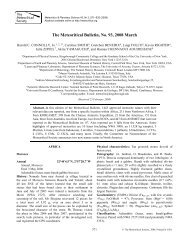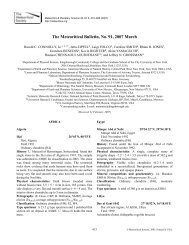Create successful ePaper yourself
Turn your PDF publications into a flip-book with our unique Google optimized e-Paper software.
576<br />
Figure 9 (a) Nickel and (b) iridium versus MgO, for igneous rocks from the <strong>Moon</strong>, Mars, and Earth. Lunar data are<br />
mainly from the compilation of Haskin and Warren (1991), the most noteworthy addition being lunar meteorite<br />
NWA773 (nickel only; Korotev et al., 2002a). Data for martian rocks are from the up-to-date (internet) version of the<br />
Meyer (1998) compilation. Data sources for terrestrial rocks are too numerous to list, but include Crocket and<br />
MacRae (1986), Brügmann et al. (1987), and the compilation of Govindaraju (1994).<br />
any pressure (Taylor et al., 1991; Longhi, 1992;<br />
Papike et al., 1998). <strong>The</strong> inference, therefore, is<br />
that long before the mare magmas formed, their<br />
source regions (i.e., much of the lunar mantle)<br />
must have been pre-depleted in plagioclase,<br />
presumably by formation of the highland crust.<br />
This concept has long been viewed as a significant<br />
argument in favor of a primordial lunar magma<br />
ocean (Taylor and Jakes, 1974; Warren, 1985).<br />
Shearer and Papike (1989) suggested that the<br />
negative europium anomalies could conceivably<br />
have formed without major plagioclase<br />
fractionation, because pyroxene can impart a<br />
negative europium anomaly by excluding<br />
<strong>The</strong> <strong>Moon</strong><br />
the relative large Eu 2þ cation during crystallization.<br />
McKay et al. (1991) reported relevant D<br />
data for lunar pigeonite. Brophy and Basu (1990)<br />
applied these and earlier D results to show that<br />
accounting for the mare europium anomalies<br />
without appeal to prior plagioclase removal<br />
requires implausible assumptions about modal<br />
mineralogy and/or degree of melting in the source<br />
regions. Assimilation/mixing with KREEP swept<br />
down into the mantle may have affected many of<br />
the mare europium anomalies, but the mare basalts<br />
with the largest negative europium anomalies tend<br />
not to have KREEP-like enriched La/Sm ratios<br />
(Figure 10).





